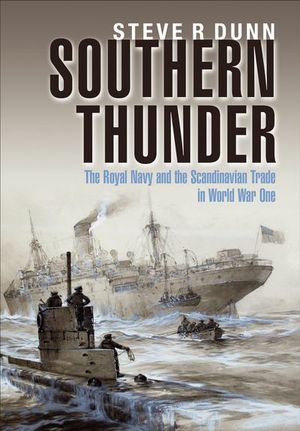Southern Thunder
Published by Pen & Sword Books
A history and analysis of the battle for the North Sea—and the crucial supplies needed by both Britain and Germany to fight the war.
During World War I, the Scandinavian countries played a dangerous and sometimes questionable game; they proclaimed their neutrality but at the same time pit the two warring sides against one another to protect their import and export trades. Germany relied on Sweden, Norway, and Denmark for food and raw materials—while Britain needed to restrict the flow of these goods and claim them for herself. And so the battle for the North Sea began.
The campaign was ferociously fought, with the Royal Navy forced to develop new tactical thinking, including convoy, to combat the U-boat threat. Many parts of Scandinavia considered that the war had missed the region, and that it was just a distant “southern thunder.” Much of that thunder was over the North Sea. This new book tells this little-known, and often ignored, story from both a naval and a political standpoint, revealing how each country, including the USA, tried to balance the needs of diplomacy with the necessities of naval warfare.
From the declaration of a British blockade to delicate negotiations, the work of Royal Navy and merchant marine sailors to Admiralty infighting over the development of a new system of convoyed vessels, this book tells the story—including a tense encounter between the US Navy and the German High Sea Fleet—and includes detailed analysis and firsthand accounts of those who were there.
During World War I, the Scandinavian countries played a dangerous and sometimes questionable game; they proclaimed their neutrality but at the same time pit the two warring sides against one another to protect their import and export trades. Germany relied on Sweden, Norway, and Denmark for food and raw materials—while Britain needed to restrict the flow of these goods and claim them for herself. And so the battle for the North Sea began.
The campaign was ferociously fought, with the Royal Navy forced to develop new tactical thinking, including convoy, to combat the U-boat threat. Many parts of Scandinavia considered that the war had missed the region, and that it was just a distant “southern thunder.” Much of that thunder was over the North Sea. This new book tells this little-known, and often ignored, story from both a naval and a political standpoint, revealing how each country, including the USA, tried to balance the needs of diplomacy with the necessities of naval warfare.
From the declaration of a British blockade to delicate negotiations, the work of Royal Navy and merchant marine sailors to Admiralty infighting over the development of a new system of convoyed vessels, this book tells the story—including a tense encounter between the US Navy and the German High Sea Fleet—and includes detailed analysis and firsthand accounts of those who were there.
BUY NOW FROM
COMMUNITY REVIEWS

